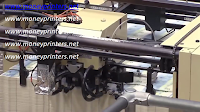How Money is Made - Paper and Ink
The paper and ink used in the production of U.S. paper currency is as distinct as its design. The paper, with the exception of $100 paper, comes to the BEP in brown paper-wrapped loads of 20,000 sheets (two pallets of 10,000 sheets). $100 paper comes to the BEP in loads of 16,000 sheets (two pallets of 8,000). Each of these sheets is tracked and accounted for as it passes through the production process.
The ordinary paper that consumers use throughout their everyday life such as newspapers, books, cereal boxes, etc., is primarily made of wood pulp; however, United States currency paper is composed of 75 percent cotton and 25 percent linen. This is what gives United States currency its distinct look and feel. For denominations of $5 and above, the security thread, and portrait or numberal watermarks are already built into the paper when it is received. For the $100 note, a 6mm wide 3-D security ribbon is woven into the paper. Tilt the note back and forth while focusing on the blue ribbon. You will see the bells change to 100s as they move. When you tilt the note back and forth, the bells and 100s move side to side. When you tilt it side to side, they move up and down. This adds a highly advanced level of security to the note.
All bills, regardless of denomination, utilize green ink on the backs. Faces, on the other hand, use black ink, color-shifting ink in the lower right hand corner for the $10 denominations and higher, and metallic ink for the freedom icons on redesigned $10, $20, and $50 bills. The $100 note's "bell in the inkwell" freedom icon uses color-shifting ink. These and the other inks appearing on U.S. currency are specially formulated and blended by the BEP. Inks headed for BEP presses also undergo continual quality testing.
HOW MONEY IS MADE-DESIGNING
 banknote designers develop the overall look, layout, and artistic details of U.S. paper currency. The design of money starts with ideas and rough sketches. Many concepts are drawn and considered before the Secretary of the Treasury approves the final design.
banknote designers develop the overall look, layout, and artistic details of U.S. paper currency. The design of money starts with ideas and rough sketches. Many concepts are drawn and considered before the Secretary of the Treasury approves the final design.
Engravers do not work on a whole note design at once. They engrave separate parts of the design on separate dies. Some engravers specialize in portraits and vignettes, others in letters and script
Currency is designed with a purpose. When redesigning a note, designers strive to convey a dignified image that reflects the strength of the American economy; retain familiar characteristics that identify a note as American currency; incorporate the latest anti-counterfeiting features; and consider how details such as outlines, tone, and shading will "translate" when engraved and printed on an intaglio press.Traditionally, banknote designers utilized classical tools like the pencil, pen and ink, or paint brush to take their visions from concept to the final model ready for the engravers. Today, the modern designer has the command of a wide array of tools including cutting edge digital technology. While the processes have evolved over time, one important tradition remains in the steadfast production of America's paper currency
Automatic High Resolution
money printing machine for sale
Money Printing Machine -
Wholesale Suppliers Online
Digital Printing Machine For
Sale – 2020 DAIWA Annual Report
NEW Automated Guaranteed Sales
Get the best deal for Money
Printer from the largest online selection at moneyprinters.net | Browse our
daily deals for even more savings!


Our Mission
Our mission is to see that you get the best quality in whatever bills you want to print. In high quality, quantity and speed. We guarantee our printers can give you that. That’s why you pay after installation and confirmed test.
Payment and Delivery
Trusted
All our clients trust us because we have the most reliable and agreeable payment method in the market, we have the best quality, we provide after sale assistance, we provide maintenance guide etc.
Automatic High Resolution money printing machine for sale https://t.co/Zd0xNXARA6 #moneyprinter #fairmoney #wealthgap #betterway #shopping #Cash
— money printing machine (@susana69919950) December 3, 2020














No comments:
Post a Comment